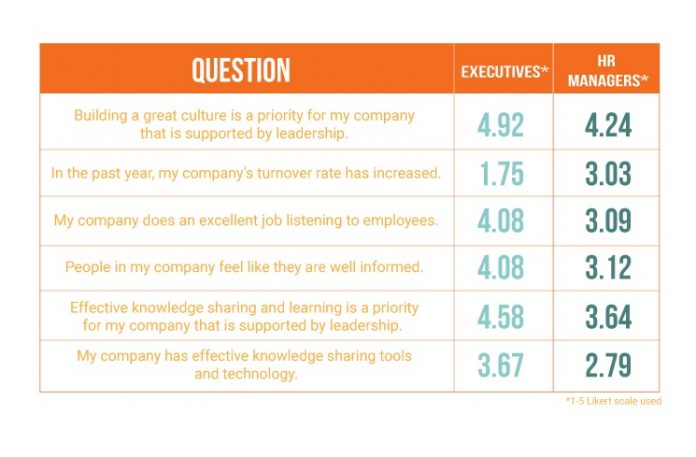
There’s a perception gap between employees and executives over the state of company culture, and it could mean bad news for business outcomes. In a recent survey distributed by culture platform Bonfyre, industry experts in positions ranging from human resources to internal communications and executive leadership roles were asked to answer questions about company culture. What we found was immense diversity in the way people perceive their workplace culture.
According to the study, HR managers and corporate executive leaders, in particular, have some big disagreements about the makeup of their culture. While they agree that a great company culture is a top priority, HR managers see employee turnover increases, while executive leaders do not.
Why is the gap in turnover perception so wide? The answer lies in their areas of disagreement. When it comes to the effectiveness of communication strategies, listening to employees, and knowledge-sharing opportunities in the workplace, HR sees room for improvement, while company leaders typically are satisfied with the current state of these areas. The full results of the survey below are based on a 5-point Likert scale, with 1 representing “strongly disagree” and 5 representing “strongly agree.”

People interpret everything in their own unique ways. It’s OK for there to be some differences in the way we perceive company culture because there is no one “right” culture. But when alignment is lacking on key elements such as communication, employee feedback, and knowledge sharing, it can lead to trouble. Miscommunication can cause a loss in productivity, which can cost organizations as much as $26,000 per employee (Integrity Solutions). An important solution to this issue is to increase listening, as 38 percent of employees (SHRM) report losing initiative when leaders dismiss their ideas without entertaining them. Create channels for company communication to ensure messages about culture are heard loud and clear.
In conclusion, analyzing internal perceptions of company culture can be an important tool in understanding the fabric that makes up the culture of an organization. When disparities occur, this can be an opportunity to assess what needs to change, and why such a difference in perception may be present. This type of assessment comes at a time when HR is expected to provide metrics and increased quantitative values in support of the crucial work they’re doing.
Chris Dornfeld is president and co-founder of Workplace culture platform Bonfyre.




